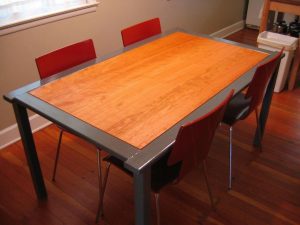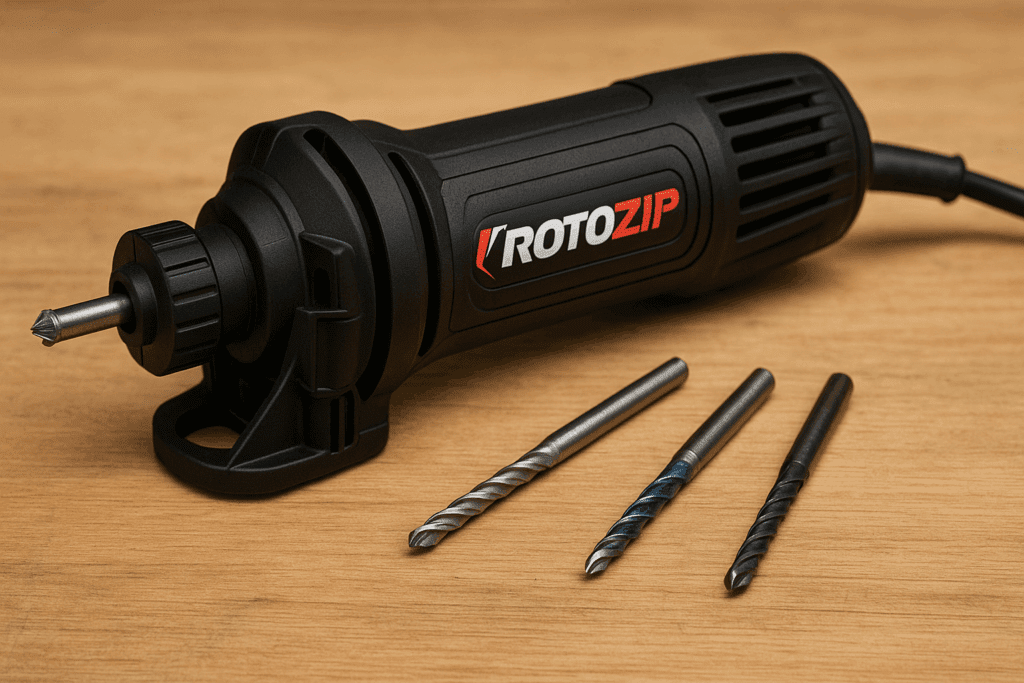
If you’ve ever tried cutting into drywall, plywood, or laminate with a jigsaw or handsaw, you probably know the struggle: rough edges, limited mobility, and time-consuming adjustments. Enter the Rotozip—a compact, high-speed spiral saw that slices through tricky materials with precision and ease.
Originally developed by a drywall installer who needed a better solution, the Rotozip has evolved into one of the most versatile tools in a DIYer’s or woodworker’s arsenal. In this guide, I’ll walk you through everything you need to know about the Rotozip: how it works, what makes it unique, where it outperforms other tools, and how to use it safely.
🛠️ What Is a Rotozip?
A Rotozip is a spiral saw—a handheld power tool that uses a rotating bit to cut through various materials in freehand shapes or plunge cuts. Unlike jigsaws or oscillating tools, a Rotozip uses a spinning bit much like a router, but in a more compact, vertical design.
Created by Bob Kopras in the 1970s, the Rotozip was designed to cut drywall around electrical boxes without needing templates. Since then, it has become popular for use on:
- Drywall
- Plywood
- Laminate flooring
- Ceramic tile (with the right bit)
- Plastic panels
- MDF
- PVC
🔗 Learn more about cutting plywood with precision in our step-by-step guide.
🧩 How the Rotozip Works
Unlike saw blades, which rely on back-and-forth motion or circular teeth, a Rotozip bit spirals rapidly (at speeds up to 30,000 RPM), grinding and routing the material as it moves. This allows the user to freehand plunge into the material and carve curves, circles, or straight lines with surprising control.
Key Features:
- Lightweight body with vertical grip
- Variable speed control
- Interchangeable spiral bits
- Dust management attachments
- Depth adjustment collar
✂️ What Can You Cut with a Rotozip?

A Rotozip is often called a “drywall router,” but that barely scratches the surface of what this tool can do. With the right attachments, you can cut:
1. Drywall
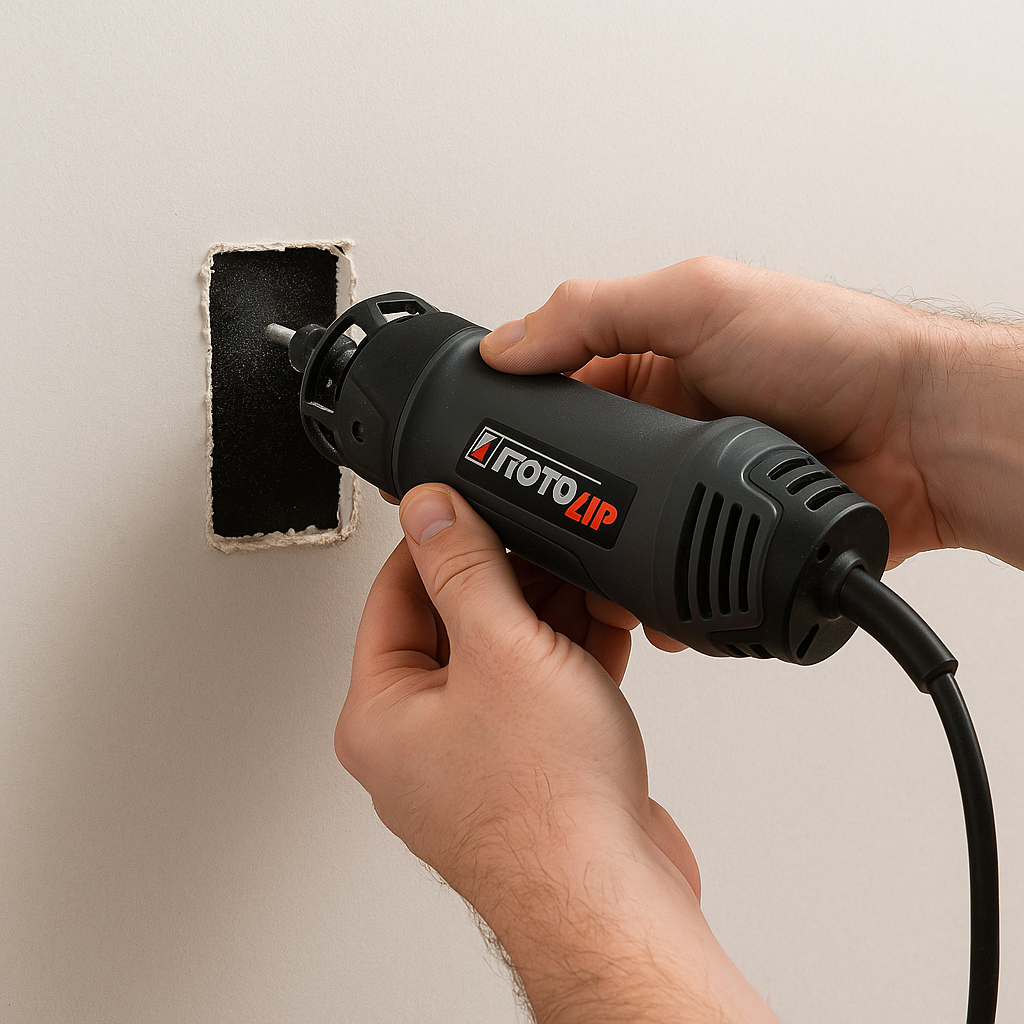
Perfect for cutting out outlets, lighting holes, and ceiling vents.
Pro Tip: Use a guide bit to follow electrical box edges without damaging wires.
2. Plywood & MDF
Useful for carving rounded corners, plunge cuts, or detail cuts in thin plywood.
🔗 Check out our tips on plywood finishes for cabinets to pair with Rotozip cuts.
3. Laminate Flooring
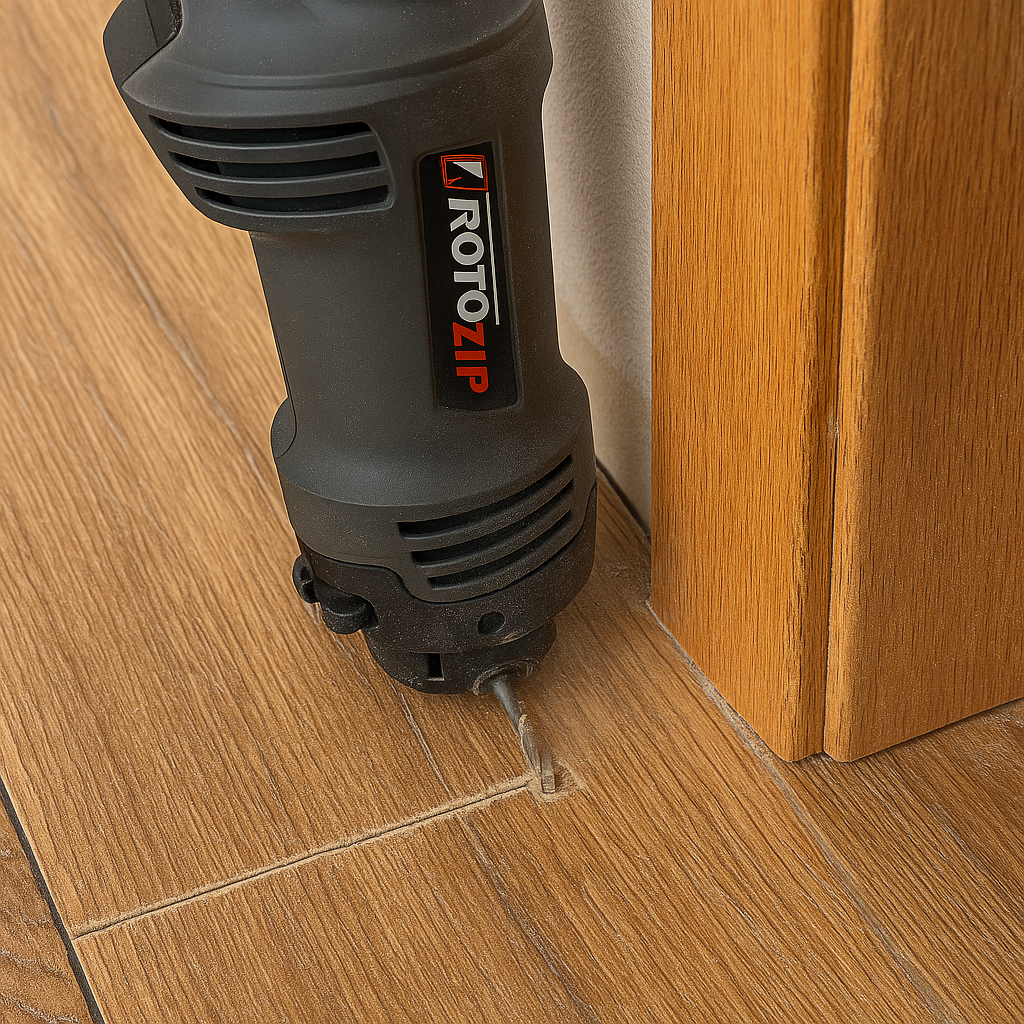
A laminate bit can carve around door frames or irregular walls.
4. Ceramic Tile
With a diamond grit bit, the Rotozip handles tile better than many rotary tools.
5. Plastic Panels or PVC
Great for plunge-cutting holes for pipe fittings or wall plates.
🧰 Top Rotozip Tools & Accessories (Amazon Picks)
Choosing the right bit or attachment matters. Here are some top-rated Rotozip products that make a difference:
🔧 Rotozip SS355-10 5.0 Amp Spiral Saw Kit
- 5.0 amp motor
- Includes multiple bits and guide attachments
- Ideal for wood, drywall, and laminate
🔧 Rotozip ZipBit Multipurpose Bit Pack
- Cuts wood, drywall, and plastic
- Perfect for general home use
Alt Text (Image Suggestion): Assorted Rotozip ZipBits on a workbench next to the tool bag
🔧 Rotozip XBits for Tile Cutting
- Diamond grit tip
- Cuts through porcelain and ceramic with precision
🧠 When to Use a Rotozip Instead of a Jigsaw or Oscillating Tool
A lot of folks ask: Why not just use a jigsaw or multitool? Here’s when the Rotozip shines:
| Task | Rotozip | Jigsaw | Oscillating Tool |
|---|---|---|---|
| Cutting drywall quickly | ✅ | ❌ | ✅ |
| Freehand shapes in plywood | ✅ | ✅ | ❌ |
| Clean plunge cuts | ✅ | ❌ | ✅ |
| Heavy-duty wood cuts | ❌ | ✅ | ✅ |
| Tile and laminate cuts | ✅ (with bit) | ❌ | ❌ |
✅ External Link: See the Rotozip in action on YouTube in this demo.
🧱 DIY Project Ideas
Here are a few hands-on ways I’ve used my Rotozip around the house:
📌 Build Custom Wall Niches
Plunge into drywall and route out a recessed alcove for shelving. Just use a straightedge guide and a drywall bit.
📌 Install Recessed Lighting
It makes clean, circular cuts for ceiling cans—faster and cleaner than a hole saw.
📌 Modify a Plywood Cabinet Face
Need to carve a custom handle cutout? A Rotozip glides through ¾” plywood with ease using a spiral wood bit.
🔗 Explore our guide on building plywood cabinets to see where you can integrate Rotozip cuts.
⚠️ Safety Tips
Rotozips are powerful tools, and they demand careful handling. Here’s what to keep in mind:
- Always wear eye protection—bits can kick back debris.
- Use hearing protection if cutting for long periods.
- Clamp material or use guides when possible to prevent slips.
- Start cuts outside the material edge, then move inward.
- Keep the cord clear of your cutting path (or go cordless).
🧽 Maintenance & Bit Care
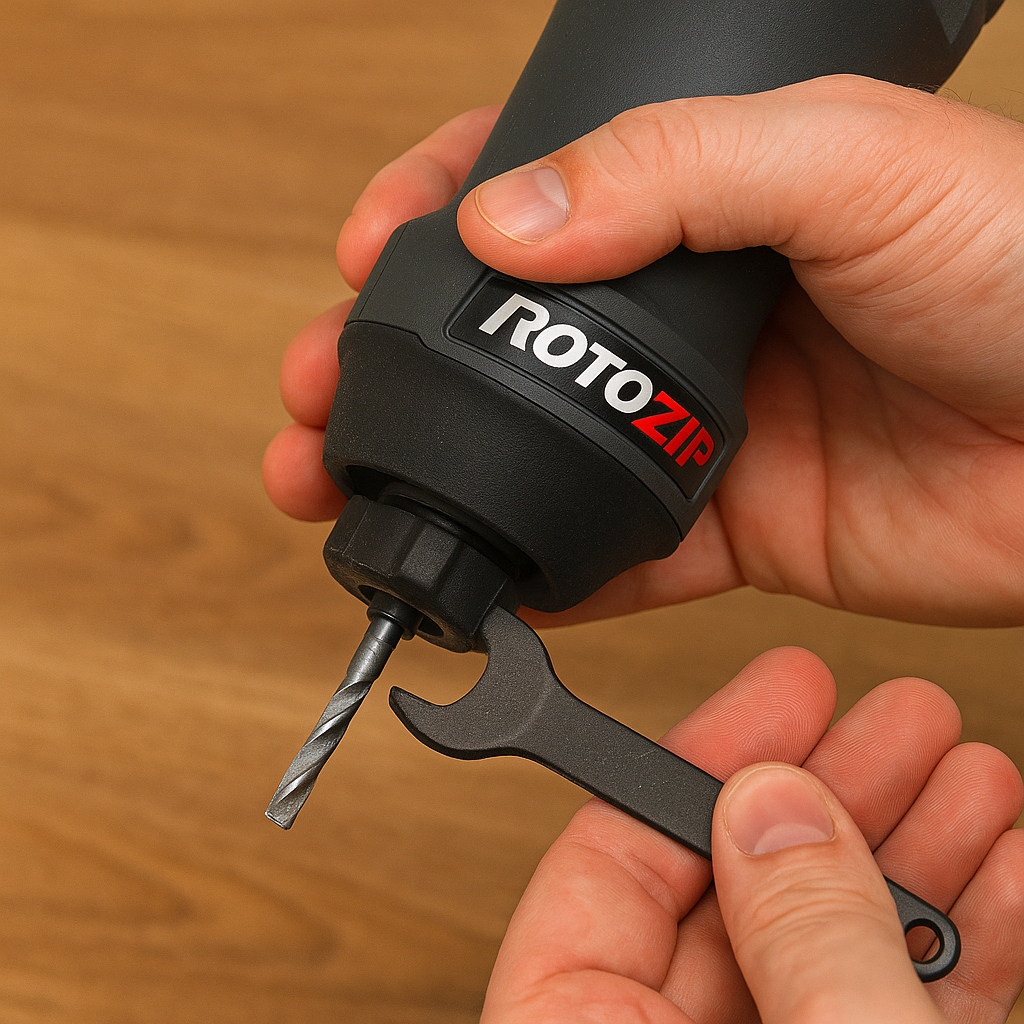
A Rotozip bit can wear out faster than a standard saw blade, especially on abrasive materials like tile or MDF. Here’s how to keep your tool running smoothly:
- Replace bits often for clean cuts.
- Keep the housing dust-free using compressed air.
- Lubricate moving parts according to your user manual.
- Use dust collection attachments when working indoors.
💡 Pro Tips from the Workshop
From years of tinkering and renovation projects, here are a few takeaways I’ve learned the hard way:
- Always test on scrap first. Rotozip bits don’t behave exactly like routers or drills—each material reacts differently.
- Let the bit do the work. Don’t force the tool; it will bind or burn the material.
- Go clockwise around cutouts. It reduces chip-out and splinters.
- Use the depth collar. It prevents overcutting when working near walls or studs.
🧰 Who Should Buy a Rotozip?
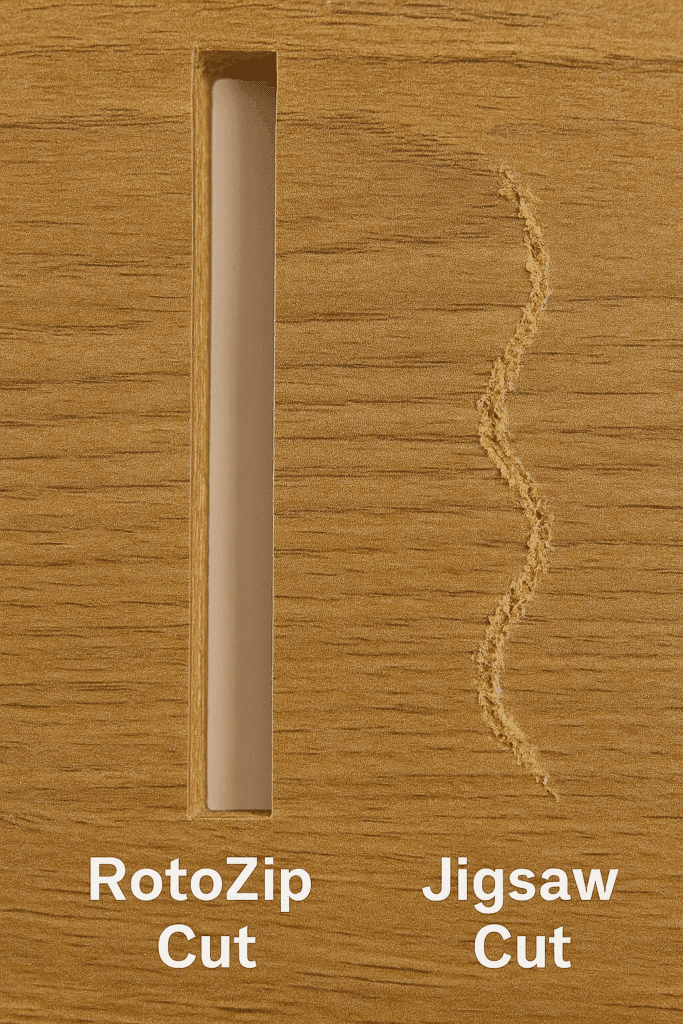
If you’re a DIYer, woodworker, remodeler, or electrician, it can save hours of cutting and measuring time. It’s especially helpful for:
- Home renovation projects
- Sheetrock installation
- Cabinet modifications
- Floor installs
- Panel retrofits
Even casual users will appreciate how much faster it is for detailed work.
For more DIY upgrades, check out our woodshop setup guide to find tools worth adding alongside your Rotozip.
🔚 Final Thoughts
The Rotozip isn’t just a niche tool for drywall installers—it’s a powerful, multipurpose cutter that belongs in every serious DIYer’s toolkit. Its ability to handle detailed plunge cuts, laminate shapes, and fast drywall carving makes it a go-to when other tools fall short. Whether you’re renovating a room or crafting a custom cabinet, the Rotozip earns its spot on the bench.




